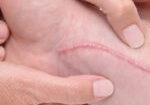J. F. Goubau, L. Goubau, A. Van Tongel, P. Van Hoonacker, D. Kerckhove, B. Berghs (2013).The wrist hyperflexion and abduction of the thumb (WHAT) test: a more specific and sensitive test to diagnose de Quervain tenosynovitis than the Eichhoff’s Test. J Hand Surg Eur Vol. 2014 Mar; 39(3): 286–292. Published online 2013 Jan 22. doi: 10.1177/1753193412475043
“The WHAT test is performed as follows: the wrist is hyperflexed and the thumb abducted in full MP and IP extension, resisted against the therapist’s index finger. Exacerbation of the symptomatology is considered a positive test result”.
The Skinny- When choosing a provocative test for De Quervain’s disease (De Quervain’s Tenosynovitis Test), therapists in the past have typically chosen from two popular tests; Eichoff’s test and Finkelstein’s test. The latter often being confused with the first. This study compares Eichoff’s test to a new test called The Wrist Hyperflexion and Abduction of the Thumb test (wrist hyperabduction test – WHAT). The study included 100 patients experiencing de Quervain tendinopathy between the years 2007-2010.
In The Weeds-Each patient underwent the Eichoff’s test and the WHAT test in random order by two experienced hand surgeons (test for de quervain’s tenosynovitis). Each provocative testing procedure was carried out in the same sequence to ensure consistency. Patients who tested positive under either test were sent for X-ray and ultrasonography to confirm the diagnosis of de Quervains.
Results: Ninety-three ultrasounds were positive and seven were negative. The accuracy of Eichoff’s test was .84 while the accuracy of the WHAT test was .94, suggesting that the latter performs better overall in establishing the correct diagnosis. The WHAT test also produced a better sensitivity at .99 and specificity at .29.
Bring it Home- A new test known as the WHAT test was developed due to the controversy associated with the accuracy of Eichoff’s test, and also the need for a more patient-friendly test for use in daily practice. This study found the WHAT test to be superior in all categories. This may be due in part to the specific mechanics of the WHAT test, positioning the anatomy in a way to accurately detect even the earliest symptoms.
This study was transparent about their methodology and had well thought out methods including sequence protocols for each provocative test for consistency, random order, and a large sample size. Using ultrasound technology to confirm the results of the in-clinic provocative testing provides a reliable diagnosis for comparison. Detailed explanations of the WHAT test were also provided along with pictures and illustrations of the anatomy, showing the superior mechanism of the test.
2 Comments
Leave a Comment
More To Read
How to Improve HEP Adherence for Optimal Rehabilitation Outcomes
By Sophia Grimm A lack of adherence to home exercise programs in rehabilitation is a significant problem, with nonadherence estimates as high as 30-65% for general musculoskeletal conditions. This could have potentially detrimental effects on patients’ clinical rehabilitation outcomes as the success of certain medical interventions depends largely on patient adherence to advice and prescribed rehabilitation…
Read MoreScar Management in Hand Therapy
Hand therapists may feel they are in a constant battle with scar tissue. It can limit ROM, cause pain, impede other structures, and leave a less than desirable appearance. Scar tissue starts forming as early as 2 weeks after an injury and can continue forming for up to 2 years. The earlier action is taken…
Read MoreEffectiveness of Conservative Therapy and Splinting for 1st CMC OA
Tsehaie, J., Sprekraijse, K., Wouters, R., Slijper, H., Feitz, R., Hovious, S., & Selles, R. (2018). Outcome of a Hand Orthosis and Hand Therapy for Carpometacarpal Osteoarthritis in Daily Practice: A Prospective Cohort Study. American Society for Surgery of the Hand, 1-11. The skinny: Non-surgical approaches (hand therapy & orthotics) are typically the go-to for…
Read MoreShould we still be immobilizing the thumb in scaphoid fractures, or is a wrist-only cast just as effective?
Article:Harper, K. J., Rees, Y., Tan, N. X., Li, H., Fonseca, E. A., Quach, P. G., Lee, G. S., Brayshaw, J.R., & McGarry, S. (2025). Determining the success of clinical outcomes for thumbimmobilization compared to no thumb immobilization in adult non-displaced, non-surgically managed scaphoid fractures: A systematic review. Hong Kong journal ofoccupational therapy. The Skinny:This study…
Read MoreSign-up to Get Updates Straight to Your Inbox!
Sign up with us and we will send you regular blog posts on everything hand therapy, notices every time we upload new videos and tutorials, along with handout, protocols, and other useful information.







I am looking forward to performing this test along with the Eichoff’s test. I think that if both are positive then it provides the physician with more information at their next MD appointment. I find that this diagnosis is often missed with my wrist sprain/strain patients.
Thank you for this information.
Nice post, I really appreciate you for sharing this informative post. Thanks